Laboratory Facilities and Services
Department of Materials and Rheology
-
The gas sorption analysator Quantachrome Autosorb iQ (BET) for physical adsorption analysis.
The adsorption method for determining of specific surface area is preferred to other methods owing to its sensibility, accuracy and application ranges. The BET method (named according to Brunauer, Emmett a Teller) is the most reliable method widely used for the determination of the surface area of solids and powders.
The method is standardized: ISO 15901-2 Pore size distribution and porosity of solid materials by mercury porosimetry and gas adsorption. Part 2: Analysis of mesopores and macropores by gas adsorption; DIN 66131: Determination of specific surface area of solids by gas adsorption according to Brunauer, Emmett a Teller (BET).
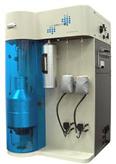
The gas sorption analyser (including accessories) for physical adsorption is used for qualitative and quantitative characterization of texture and morphology of solid materials, e. g. powders, blocks, granules and composites. Specific surface area is an important property of powders, which affects so-called surface activity as well as other properties such as dissolution rate, electrostatic properties, light scattering, impermeability and etc. Similarly, many physical properties of high porous materials are influenced by the ability of sorption and desorption of gases and vapours.
-
The gas pycnometer Quantachrome Pentapyc 5200e with accessories used for measuring the density and volume of powders, solid and compacted materials (building materials, rock core plugs, etc.) and pastes.
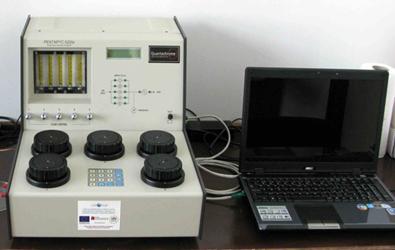
The gas pycnometry with accessories is used for measuring the density and volume of powders, solid and compacted materials (building materials, rock core plugs, etc.), and pastes. Density of solid materials in building industry (binders, fillers, mineral admixtures, industry wastes, etc.) plays an important role, not only for the characterization of structure, but also for development of new progressive materials. The amount of sample used in gas pycnometry is higher in comparison with commonly used fluid pycnometry. The sample can be reused again for other applications.
Modern gas pycnometers are doted with functions designed to increase accuracy and reproducibility, to evaluate and to store the measured the results
Methods of gas pycnometry are standardized: STN EN ISO 1183-3 Plastics. Methods for determining the density of non-cellular plastics. Part 3: Gas pycnometry method; STN ISO 8130-2 Coating powders. Part 2: Determination of density by gas comparison pycnometry (referee method); STN EN ISO 18753 Fine ceramics (advanced ceramics, advanced technical ceramics) – Determination of absolute density of ceramic powders by pycnometry , ASTM C188-95 Standard Test Method for Density of Hydraulic Cement ; ASTM D5550-00 Standard Test Method for Specific Gravity of Soil Solids by Gas Pycnometry.
-
Mercury intrusion porosimeter (MIP) Quantachrome Poremaster 60GT used for pore structure analysis.
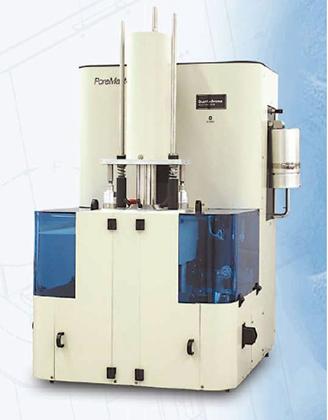
Mercury intrusion porosimetry is based on the physical principle that a non-reactive, non-wetting liquid will not penetrate the fine pores until sufficient pressure is not applied to force its entry. This is a technique used to measures pore size and pore volume distribution of pores from 0.5mm to 1.8nm. It is used for qualitative and quantitative characterization of porous materials, e. g. powders and compacted materials. Current devices together with the installed software allow the processing and the analysis of data.
Methods of mercury porosimetry are standardized: ASTM D440-84(2004) Standard Test Method for Determination of Pore Volume and Pore Volume Distribution of Soil and Rock by Mercury Intrusion Porosimetry; ASTM D4284-07 Standard Test Method for Determining Pore Volume Distribution of Catalysts by Mercury Intrusion Porosimetry; ASTM UOP578-02 Standard Test Method for Determining Pore Volume Distribution of Catalysts by Mercury Intrusion Porosimetry; DIN 66133:1993-06 Determination of pore volume distribution and specific surface area of solids by mercury intrusion; ISO 15901-1 (2005) Pore size distribution and porosity of solid materials by mercury porosimetry and gas adsorption — Part 1: Mercury porosimetry; BS7591-1:1992 Porosity and pore size distribution of materials. Method of evaluation by mercury porosimetry.
-
Simultaneous thermal analysis Mettler Toledo Star TGA/DSC-1
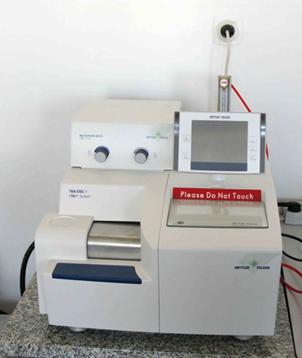
Equipment for simultaneous thermal analysis TGA/DTA serves to characterize the phase transition temperatures and also to determine qualitatively and quantitatively the thermodynamic changes in the material based on the difference between temperatures of sample and reference material as a function of programmed temperature (DTA) or weight (TGA). Therefore the emphasis is on precision and sensitivity of the weighted materials. The other contributions of such equipment are the determination of main components and the purity of materials, the characterization of materials and other application in research and development of new composites.
Method is standardized according to DIN 51007 General principles of differential thermal analysis.
-
Differential scanning calorimeter DSC Mettler Toledo Star DSC-1
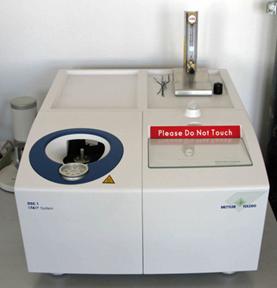
Differential scanning calorimeter (DSC) is used for measurement of characteristic temperatures of the phase transitions and also for quantitative determination of the enthalpy associated with physical and chemical changes in materials. Calorimeter has also other possibilities of utilization: determination of specific heat capacity, purity of materials, description of reaction kinetics, research and development of new composites.
Method is standardized according to: DIN 51007 General principles of differential thermal; DIN 53765 Testing of plastics and elastomers; thermal analysis; DSC-method, ASTM D3418 Standard Test Method for Transition Temperatures and Enthalpies of Fusion and Crystallization of Polymers by Differential Scanning Calorimetry.
-
Motorized optical microscop OLYMPUS BX-61
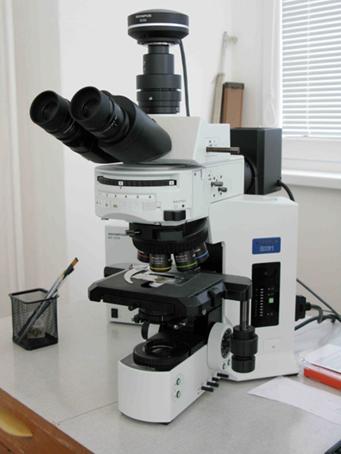 Motorized microscope is equipped with digital camera. The monitoring of pictures is designed to analyse pore structure, surface texture of solid materials in reflected and transmitted light and also to determine quantitatively the characteristics associated with the phase composition by picture analysing. Microscope is used to:
Motorized microscope is equipped with digital camera. The monitoring of pictures is designed to analyse pore structure, surface texture of solid materials in reflected and transmitted light and also to determine quantitatively the characteristics associated with the phase composition by picture analysing. Microscope is used to:
- detect the shape and size of granular and fibrous materials,
- analyse the nature and distribution of fibrous reinforcement in the composites,
- observe the nature and shape of crystals in the pores of the material after influence of salt solutions,
- determine the purity of materials,
- observe the changes in the surface and texture of composite materials after application of stress,
- evaluate corrosion of metal surfaces in a variety of environments and,
- use for special purposes in research and development of composites.
-
Professional stereoscopic microscope KAPA STM 723
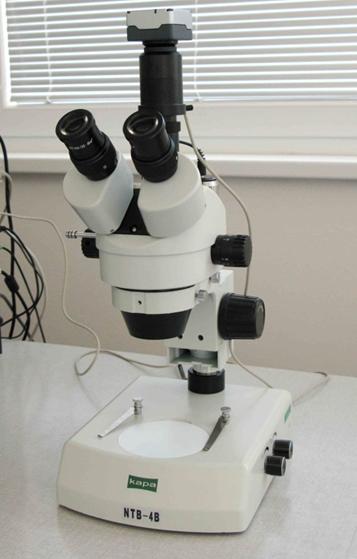 Stereoscopic microscope KAPA STM 723 is equipped with lighting and also digital video camera with the possibility to exchange to a digital camera and with scanning software having basic functions for analysis a processing of pictures.
Stereoscopic microscope KAPA STM 723 is equipped with lighting and also digital video camera with the possibility to exchange to a digital camera and with scanning software having basic functions for analysis a processing of pictures.
The microscope will be used primarily for rapid and routine surveillance specimens in reflected and transmitted light.
-
Rheological measurements: Tests of fresh and hardened cement composites, setting time, workability, volume of air in fresh compacts
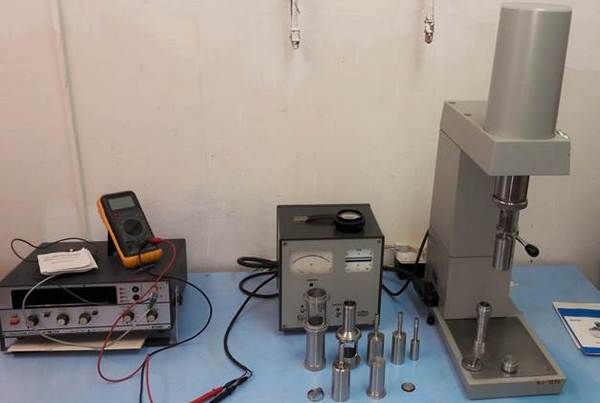
-
Physical tests: volume changes due to expansion or shrinkage, specific surface of powders (BLAINE test), density and bulk density measurement of powders.
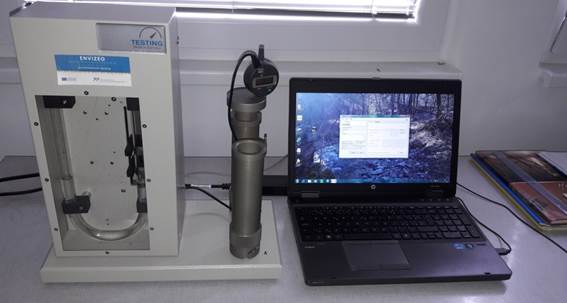
Services
- pH Measurement.
- Conductivity measurement and water permeability
- The four-planetary mill with accessories
- Durability diagnosis: research and monitoring, visual description and photograph. Permeability and absorption capacity measurement. Carbonation (Carbonation depth measured using phenolphthalein). Resistance to frost and deicer salts.
- Reinforcement Corrosion (electropotential measurements using half-cell arrays and electrical resistance method). evaluation of corrosion Inhibitors.
- Chloride ion content (a major contributor to structural deterioration).
- Corrosion of concrete in various liquid aggressive media.
- Measurement: Chemical Analysis, preparing of analytical samples by crushing and grinding.
- Mechanical test: compressive and tensile Strength, modulus of elasticity, hardness (by Schmidt Hammer).
- Crushing a concrete core samples concrete
- Evaluation of performance of mortars and concretes.
- Development of innovative binder systems including utilization of industrial byproducts.
- Consultancy Research and technical consulting (a complete service for architects, surveyors, and for clients direct). This includes on site sampling, inspection and testing, laboratory testing, evaluation of materials and provision of comprehensive reports including repair recommendations. Consulting in whole broad area of the building chemistry and in the fields of buildings, structures and construction materials.
- Diagnostics: we offer a complex range of structural diagnostic examinations. Most tests are carried out in-situ in a non-destructive way at minimum costs. The result and the reports are used as a basis for the assessment of structures, for the determination of their load-bearing capacity and for further design stages in compliance with the client requirements.

 contact
contact